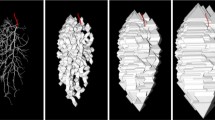Abstract
Myocardial blood flow exhibits the most marked heterogeneity at the microvascular level. Its within-layer spatial distribution can be described from subepi- to subendocardium with resolutions of 0.1 × 0.1 to 1 × 1 mm2 by quantitative digital radiography based on the technique of desmethylimipramine deposition. In the subendocardium, flow heterogeneity is the highest, whereas local flow randomness is the lowest, showing the clustered pattern of high- or low-flow regions. The resolution-dependence of flow heterogeneity is characterized by its fractality, which holds consistently down to the microvascular level through the vascular structural transition from the treelike arteriolar to the non-treelike capillary network. Flow heterogeneity is adjustable in a transmurally different manner to local metabolic changes. The redistribution of flow is considered as a result of adaptive coordination of microperfusion between adjacent microcirculatory units, which are perfused by a single precapillary arteriole.
Similar content being viewed by others
Author information
Authors and Affiliations
Additional information
Received: 28 February 2001, Returned for revision: 2 May 2001, Revision received: 31 May 2001, Accepted: 19 June 2001
Rights and permissions
About this article
Cite this article
Matsumoto, T., Kajiya, F. Microheterogeneity of myocardial blood flow. Basic Res Cardiol 96, 547–552 (2001). https://doi.org/10.1007/s003950170005
Issue Date:
DOI: https://doi.org/10.1007/s003950170005




